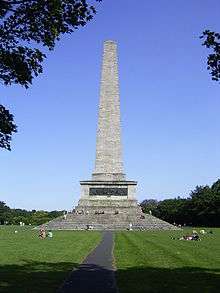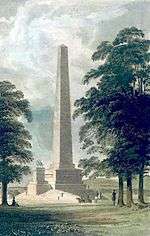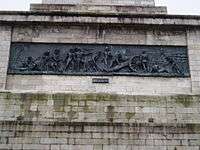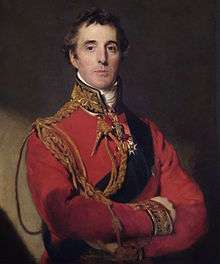Wellington Monument, Dublin
The Wellington Monument (Irish: Leacht Wellington),[1] or more correctly the Wellington Testimonial,[note 1] is an obelisk located in the Phoenix Park, Dublin, Ireland.
The testimonial is situated at the southeast end of the Park, overlooking Kilmainham and the River Liffey. The structure is 62 metres (203 ft) tall, making it the largest obelisk in Europe.[2]
History

The Wellington Testimonial was built to commemorate the victories of Arthur Wellesley, 1st Duke of Wellington. Wellington, the British politician and general, also known as the 'Iron Duke', was born in either counties Meath or Dublin. Originally planned to be located in Merrion Square, it was built in the Phoenix Park after opposition from the square's residents.[3]
The obelisk was designed by the architect Sir Robert Smirke and the foundation stone was laid in 1817. In 1820 it ran out of construction funds and therefore remained unfinished until 18 June 1861 when it was opened to the public. There were also plans for a statue of Wellesley on horseback but the shortage of funds ruled that out.[4]
Features
There are four bronze plaques cast from cannons captured at Waterloo – three of which have pictorial representations of his career while the fourth has an inscription. The plaques depict 'Civil and Religious Liberty' by John Hogan, 'Waterloo' by Thomas Farrell and the 'Indian Wars' by Joseph Robinson Kirk. The inscription reads:
- Asia and Europe, saved by thee, proclaim
- Invincible in war thy deathless name,
- Now round thy brow the civic oak we twine
- That every earthly glory may be thine.
Cultural references
The monument plays a significant role in Joyce's Finnegans Wake. The first page of the novel alludes to a giant whose head is at "Howth Castle and Environs" and whose toes are at "a knock out in the park (p. 3)"; John Bishop extends the analogy, interpreting this centrally located obelisk as the prone giant's male member.[5] A few pages later, the monument is the site of the fictional "Willingdone Museyroom" (p. 8).[6]
Gallery
 Engraving ca 1830
Engraving ca 1830 Monument
Monument Inscription
Inscription Plaque
Plaque 'Indian Wars'
'Indian Wars' 'Waterloo'
'Waterloo'
Footnotes
- A testimonial is erected to a living person, as Wellington was when construction started
References
- "Leacht Wellington / Wellington Monument". Irish Placenames Commission. Retrieved 1 July 2015.
- "1856 – Design for Wellington Testimonial, Phoenix Park, Dublin". Archiseek (Architecture site). 2012-01-04. Retrieved 1 July 2015.
- Garnett, P. F. (June–August 1952). "The Wellington Testimonial". Dublin Historical Record. 13 (2): 48–61. JSTOR 30105448.
- "1861 – Wellington Monument, Phoenix Park, Dublin". Archiseek (Architecture site). 2010-02-05. Retrieved 1 July 2015.
- John Bishop. Joyce's Book of the Dark: Finnegans Wake. Madison: University of Wisconsin, 1986. pp. 34-35
- William York Tindall. A Reader's Guide to Finnegans Wake. Syracuse University Press, 1969.
